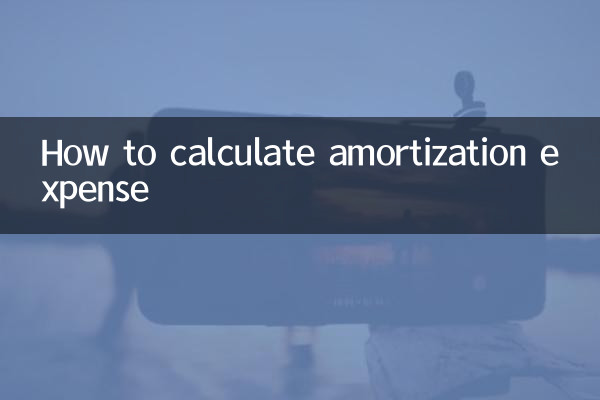How to calculate amortization expense
In the field of financial management and accounting, the calculation of amortization expense is an important link. Whether you are a business or an individual, understanding how amortization is calculated can help you better plan your finances and costs. This article will introduce in detail the definition, calculation method and related examples of amortization expense to help you fully grasp this concept.
1. What is amortization expense?

Amortization is the process of spreading the cost of a long-term asset or expense evenly over its useful life. Common amortization objects include intangible assets (such as patents, copyrights, goodwill) and long-term prepaid expenses (such as insurance premiums, rent). The purpose of amortization is to match expenses and income, in line with accounting matching principles.
2. Calculation method of amortization expense
Amortization is usually calculated using the straight-line method, which means the same amount is amortized each year. The specific formula is as follows:
| Project | formula |
|---|---|
| annual amortization | (Original value of asset - Estimated residual value) / Useful life |
| monthly amortization fee | Annual amortization fee / 12 |
The following is a specific example: Suppose a company purchases a patent worth 120,000 yuan, with an estimated useful life of 5 years and no residual value. Then the annual amortization fee is:
| Year | Amortization fee (yuan) | Accumulated amortization (yuan) |
|---|---|---|
| Year 1 | 24,000 | 24,000 |
| Year 2 | 24,000 | 48,000 |
| Year 3 | 24,000 | 72,000 |
| 4th year | 24,000 | 96,000 |
| 5th year | 24,000 | 120,000 |
3. The difference between amortization expenses and other expenses
Amortization fees are similar to depreciation fees, but they apply to different objects. Depreciation charges are for tangible assets (such as machinery, equipment), while amortization charges are for intangible assets or long-term prepaid expenses. Here's a comparison of the two:
| Project | Amortization expense | Depreciation |
|---|---|---|
| Applicable objects | Intangible assets, long-term prepaid expenses | tangible assets |
| Calculation method | Usually straight line method | Straight-line method, accelerated depreciation method, etc. |
| Residual value treatment | Usually no salvage value | There may be residual value |
4. Practical application of amortization fees
Amortization charges are widely used in corporate finance, especially in the following scenarios:
1.Amortization of intangible assets: Such as patents, copyrights, goodwill, etc., which need to be amortized within the useful life.
2.Amortization of long-term prepaid expenses: If rent or insurance is paid in advance for 3 years, it needs to be amortized monthly or annually.
3.tax treatment: Amortization fees can be used as pre-tax deductions to reduce corporate tax burdens.
5. Things to note
1. The amortization period needs to be determined based on the actual use of the asset or legal regulations. For example, a patent is usually 10 years.
2. If an asset is scrapped early or its value changes significantly, the amortization plan needs to be adjusted.
3. The accounting standards of different countries or regions may have different requirements for amortization methods, and local regulations must be followed.
6. Summary
The calculation of amortization charges is a basic skill in financial management. The straight-line method can be used to allocate long-term assets or expenses simply and efficiently. Understanding the concept and calculation method of amortization fees can help enterprises plan costs reasonably and optimize tax strategies. I hope this article provides you with clear guidance.

check the details

check the details